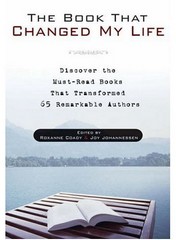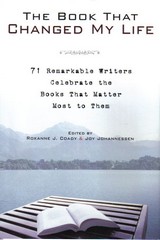On the Outside Looking In
 I am continually fascinated with the details of the book publishing business. In past entries about the writing life, I’ve written about the importance of book titles, why I work at titles and how to try out your title. A week or so ago, I received and read my October 2006 Reader’s Digest magazine. On page 24, they highlighted different ways to spend free time and instantly I was drawn to the book category. They showed the book cover for The Book That Changed My Life, 71 Remarkable Writers Celebrate the Books That Matter Most to Them edited by Roxanne J. Coady & Joy Johannessen (Gotham Books). In fact, I’ve scanned this single page from Reader’s Digest so you can see how it appeared. I know the little image in the lower right-hand corner is difficult to see but it talks about the book and includes the release date—October 19, 2006.
I am continually fascinated with the details of the book publishing business. In past entries about the writing life, I’ve written about the importance of book titles, why I work at titles and how to try out your title. A week or so ago, I received and read my October 2006 Reader’s Digest magazine. On page 24, they highlighted different ways to spend free time and instantly I was drawn to the book category. They showed the book cover for The Book That Changed My Life, 71 Remarkable Writers Celebrate the Books That Matter Most to Them edited by Roxanne J. Coady & Joy Johannessen (Gotham Books). In fact, I’ve scanned this single page from Reader’s Digest so you can see how it appeared. I know the little image in the lower right-hand corner is difficult to see but it talks about the book and includes the release date—October 19, 2006.
I received this book in yesterday’s mail and I plan to read it and write about it in mid-October, when the book should be easy to locate (or you can pre-order it with the link.). Each chapter highlights a different writer and a book which changed their life. I hope you can see why I was drawn to this subject. I know books change lives and I’m always interested in reading more about this topic.
 When I went to Amazon, I noticed they have a similar cover but not the final cover. It’s because often publishers design and send these book covers in an early stage to get them into the Amazon system. Each publishing house has different internal deadlines and systems for getting these covers to online bookstores and others. Take a careful look at the Amazon cover.
When I went to Amazon, I noticed they have a similar cover but not the final cover. It’s because often publishers design and send these book covers in an early stage to get them into the Amazon system. Each publishing house has different internal deadlines and systems for getting these covers to online bookstores and others. Take a careful look at the Amazon cover.
The image and the main title remains the same: The Book That Changed My Life.
Now take a close look at the subtitle in this image: Discover the Must-Read Books That Transformed 65 Remarkable Authors. The book image on Amazon isn’t the final image but a pre-release book cover. I suspect it was created early in the process—often before the final manuscript arrived at the publishing house. These compilation books are difficult to pull together—especially with a series of bestselling authors like the ones included in this book such as Patricia Cornwell, Nelson DeMille, Dominick Dunne, Linda Fairstein, Frank McCourt and many others. I have no idea how many authors they asked to contribute but from the finished book (shown in Reader’s Digest and I have one), they received 71 contributors instead of 65.
 This additional material called for a change in their subtitle and a higher page count on their finished book. When I saw that Amazon had the wrong cover, I searched for the finished book cover. I went to Google, selected image and searched for it. The finished book cover didn’t show up, but I did learn there was another book with the same title (different subtitle) which was released in 2002 and covers National Book Award Winners and Finalists. I could find numerous versions of this other book, The Book That Changed My Life, Interviews with National Book Award Winners and Finalists but Google image didn’t find the image for the cover that I need.
This additional material called for a change in their subtitle and a higher page count on their finished book. When I saw that Amazon had the wrong cover, I searched for the finished book cover. I went to Google, selected image and searched for it. The finished book cover didn’t show up, but I did learn there was another book with the same title (different subtitle) which was released in 2002 and covers National Book Award Winners and Finalists. I could find numerous versions of this other book, The Book That Changed My Life, Interviews with National Book Award Winners and Finalists but Google image didn’t find the image for the cover that I need.
Since I didn’t find what I needed with my search—and since I had a finished book in hand, I scanned my own book cover and you can see this image with the correct subtitle: The Book That Changed My Life, 71 Remarkable Writers Celebrate the Books That Matter Most to Them. Reader’s Digest managed to have the correct cover but Amazon has an earlier version.
I have no connection to this publisher so I know nothing about their internal process or when this subtitle changed in the book production process. Because books are produced over a series of months, it could have been in the distant past or in the near past. I do know these subtitles (or other elements of a book) can be changed until the book goes to the printer. Even when a book is at the printer, if something crucial needs changing, it can be changed—right up until the minute the book goes on the press and they begin printing.
Today, you may be wondering how you can get a literary agent or a book editor interested in your book proposal or your book manuscript. You may be on the outside looking in and unsure how to get anyone’s attention. First, recognize the importance of crafting an excellent book proposal and the importance of your book concept and the book title. I’ve been in acquisitions meetings, where the entire room of publishing executives are persuaded about the book and most of this persuasion comes from an attractive title. Everyone knows any book with such a title will be find readers.
Also recognize the importance of fostering and building relationships with editors and other leaders within the publishing house. Often you can build that relationship at a writer’s conference. I understand it’s an investment of time, money and energy to get to these conferences but if you want to get your book idea into the marketplace, you probably need to make this investment.
If you keep your eyes open, any of us can learn a great deal—even if we are on the outside looking in.





















1 Comment:
I'm curious as to what extent the decisions in the publishing industry are driven by the personal interests and inclinations of those involved. There has been some chatter recently on literary agent blogs regarding agents only accepting books they take a personal interest in and editors doing the same. In my own case, I believe I've written a book on an important topic constantly in the news that is also quite marketable. It is available at my blogsite and independent readers say a lot of good things about it, so it must have some merit. Unfortunately, I've repeatedly hit a brick wall in drawing the interest of the publishing community. I've struggled to understand why, and believe it can be at least partly explained by my use of science and technology within a fiction setting - which seems to be greatly frowned up. I've written about my experiences at the e-zine Lab Lit, at http://lablit.com/article/83 . Having been involved in the acquisitions process, I'd be curious if you have any comments on my general conclusions.
In any case, I appreciate anyone from the publishing industry providing insights to those of us outside of the conference room. Thanks for taking the time to do that.
Post a Comment
That's the writing life...
Back to the home page...